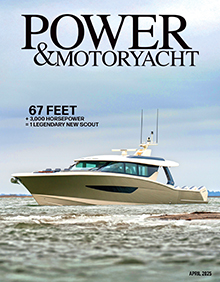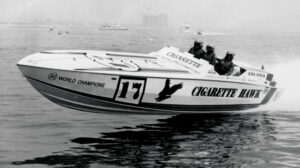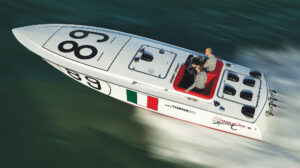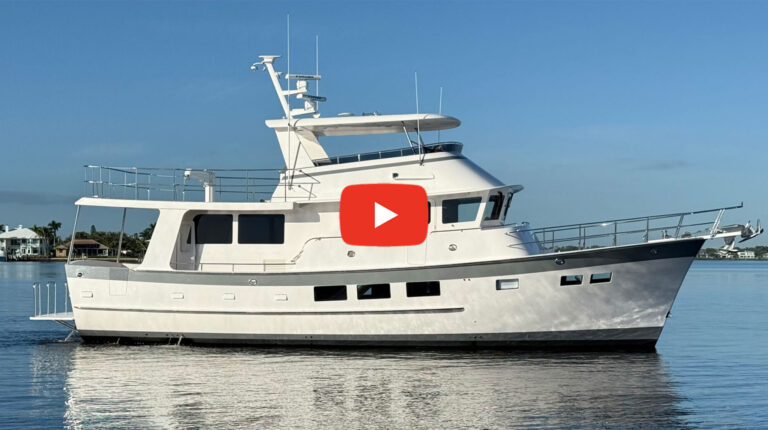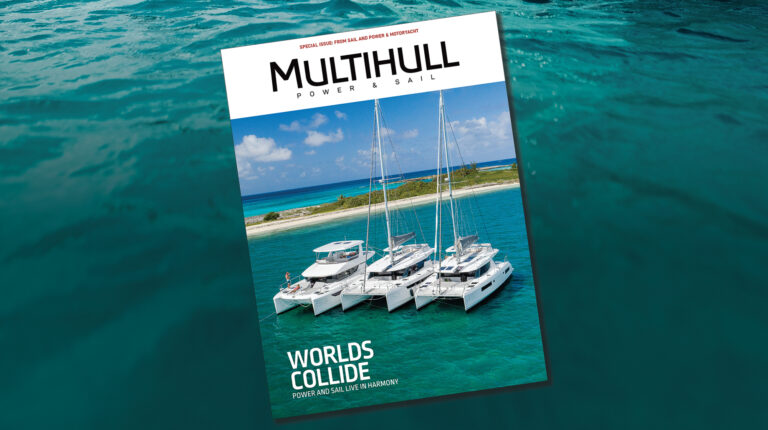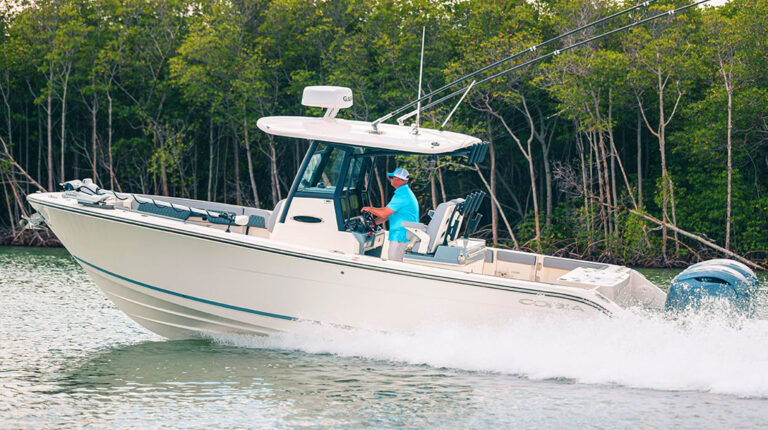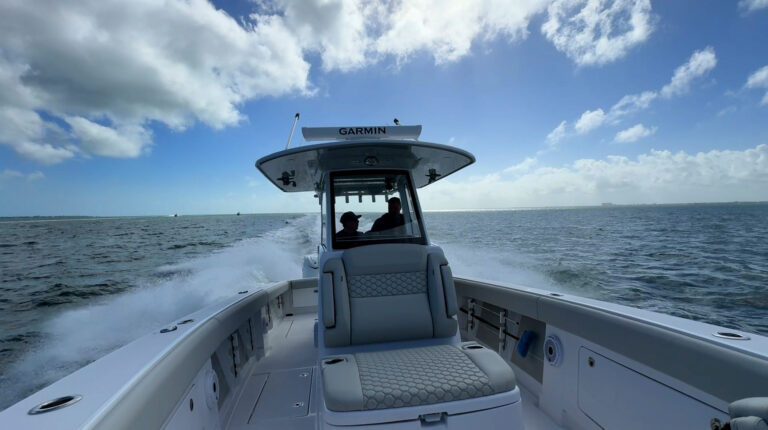Joysticks for Everyone
With the introduction of the Cummins Inboard Joystick system, drivers of boats of all types can now dock like they’re playing a video game.

Remember when pod drives came out? The inboard was going to go the way of the carburetor and cable controls. Joystick docking and operation were going to make maneuvering a 75-foot yacht as easy as it is for my 12-year-old son to drive a Ferrari when playing the Grand Theft Auto video game on his Playstation 3.
Well all that stuff’s in our collective wake now. The buzz over pods has died down and, while they still have their place, inboards continue to be in demand, too. Inboard propulsion is basically less expensive to purchase, to own, and to maintain. And now, thanks to Cummins Marine (marine.cummins.com), inboard enthusiasts can own yet another type of joystick system, the Cummins Inboard Joystick.
“We saw a flattening or saturation in the pod market and we saw people being infatuated with joystick controls in a boat,” said Andy Kelly, Marketing Communications Specialist at Cummins. The company began investigating joystick systems for inboards in 2012 and the Cummins Inboard Joystick is being unveiled on a 2014 model from Sea Ray at this month’s Ft. Lauderdale International Boat Show. According to Cummins, the Inboard Joystick system will only be available on new boats for now, but Cummins hopes to have the technology as an aftermarket item in the future.
Thanks to Volvo Penta’s IPS and Cummins/MerCruiser’s Zeus packages, pod-driven owners have enjoyed joystick operation for about a decade now. Over the past couple of years, MerCruiser’s Axius and Volvo’s Joystick Driving System let owners of boats with Bravo Three and Duoprop drives respectively maneuver their vessels with joysticks. Even outboard owners have experienced the fun of joystick operation with systems from Teleflex and Yamaha.
And of course on the inboard side, the Cummins system is not the first. That honor goes to Twin Disc with its QuickShift-transmission-inspired Express Joystick System, which gives the skipper joystick command over the engines, albeit typically with expensive hydraulic thrusters. Still another option is the Xenta VMA Plus system, which uses sensors and electronic controls to add joystick control to virtually any twin-screw diesel boat equipped with a bow thruster (See “Joystick System Add-Ons for Twin Diesels”.
Along similar lines, the Cummins Inboard Joystick is designed for boats that run Cummins diesel power and range from 35 to 70 feet in length. It utilizes twin engines, an electric bow thruster, and sometimes a stern thruster to give the operator complete control when docking. Still another option is the Xenta VMA Plus system, which uses sensors and electronic controls to add joystick control to virtually any twin-screw diesel boat equipped with a bow thruster (See “Joystick System Add-Ons for Twin Diesels”.
“You buy the engines, the electronic controls, the joystick controller, the harnessing, the thruster and the thruster tube from one source,” explained Kelly. “It’s all backed up, warranted, serviced, and supported in the field by Cummins. One phone call and you can have entire propulsion system maintained.” The system has a two-year/1,000-hour warranty.
The Cummins Inboard Joystick system is intended exclusively for docking. While some pod joysticks allow operators to run their boats in open water as well as no-wake zones, the Cummins product is intended for owners to use when they are maneuvering into their slips.
Some may be surprised that the Cummins Inboard Joystick utilizes 12-volt thrusters because, traditionally, DC-powered thrusters have been known to overheat and shut down in what’s known as a “thermal trip.” And it never happens at a good time. Part of this problem, of course, can be attributed to overly prolonged usage, during which the skipper relies too much upon his thruster and not enough upon his own boat-handling skill.
Kelly explained that the Extended Run Thrusters in the system were developed exclusively for Cummins. The units are designed to run longer than traditional DC thrusters without overheating. They are 24 volt, but can be adapted to 12-volt systems too. Cummins provides thruster monitoring in the form of an LED indicator on the control pad so users can keep an eye on thruster run time and battery usage.
Initially, Cummins will launch with two-station availability. In the future, however, Cummins is planning to add a third-station capability and eventually, there will be joystick-only auxiliary stations. Unlike the joysticks with Cummins Zeus, which have a separate control pad, the inboard-type joystick and pad are contained within the same bezel for ease of operation and installation. This also takes up less space on a boat’s dash panel.
Additionally, Kelly emphasized that the Cummins Inboard Joystick is much simpler than the Zeus system. There are fewer components involved and they all go the plug-and-play route with easy-to-connect wires, relays, and solenoids, so adding that third station is bound to be a much more straightforward task.
As with Zeus applications, Kelly explained that Cummins will configure Inboard Joystick technology with manufacturers on a boat-by-boat basis, determining if a given model needs a bow thruster only or if a stern thruster must be added. Either way, if you’re into good-old-fashioned, straight-shaft inboard propulsion and reasonably priced electric thrusters, you’ve now got a joystick option.
Have Pods Peaked?
When a company that builds popular pod drives comes out with a joystick system for inboards, one can’t help but wonder: Are they doing this because pods are losing traction? Does this mean pods have peaked? Not necessarily. The latest development at Cummins Marine seems to mean that inboards haven’t died off the way some had forecast. “There are still people out there attracted to shaft drive, especially in coastal areas,” said Randy Peterson, Director of Engineering at Marquis Yachts. He explained that Marquis and its sister company Carver are still working on new hull designs for pods, but they are also developing new models for inboards as well.
This article originally appeared in the November 2013 issue of Power & Motoryacht magazine.

